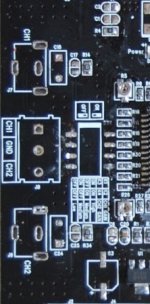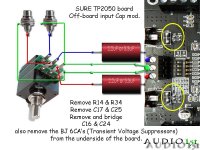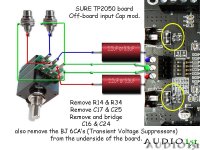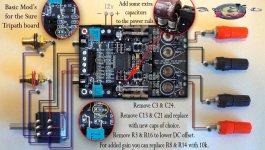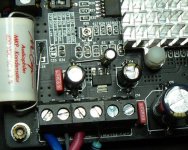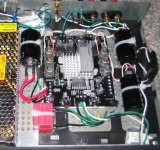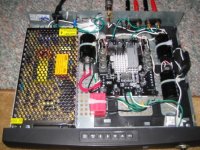Could anyone (may be Audio1st) confirm this for me, please...
In order for me to use the input caps off board (as in the Sure T2024 board picture), I need to remove C16 and C24 and bridge them, C17 and C25, and finally R14 and R34 then connect the input caps between the pot terminals and the screw-in input terminals (CH1/GND/CH2). Of course I am talking about the TK2050 board using the T2024 pix as references.
What about the two caps under the board?
I have read the threads and still am a little confusing.
Thanks in advance.
Cheric
In order for me to use the input caps off board (as in the Sure T2024 board picture), I need to remove C16 and C24 and bridge them, C17 and C25, and finally R14 and R34 then connect the input caps between the pot terminals and the screw-in input terminals (CH1/GND/CH2). Of course I am talking about the TK2050 board using the T2024 pix as references.
What about the two caps under the board?
I have read the threads and still am a little confusing.
Thanks in advance.
Cheric
Attachments
Audio1st,
Thank you so very much for your help.
Your diagram has solved all my questions. You have been a great one!
Again, thank you.
Cheric
Thank you so very much for your help.
Your diagram has solved all my questions. You have been a great one!
Again, thank you.
Cheric
Cheap SMPS
I found a closeout on HP Laser Printer power supplies: 32V, 2.34A (75 watts), $12.99, free shipping.
The company is The Printerworks on ebay:
http://cgi.ebay.com/HP-AC-Power-Sup...0?hash=item53da5b8f97&_trksid=p3286.m20.l1116
I've ordered two of them for my two 2*100watts boards (which have not yet arrived from China). I'll let you know how they work when everything gets here.
Is it too much to hope that the connector plug on the power supply will fit the jack on the board?
dr_vega
I found a closeout on HP Laser Printer power supplies: 32V, 2.34A (75 watts), $12.99, free shipping.
The company is The Printerworks on ebay:
http://cgi.ebay.com/HP-AC-Power-Sup...0?hash=item53da5b8f97&_trksid=p3286.m20.l1116
I've ordered two of them for my two 2*100watts boards (which have not yet arrived from China). I'll let you know how they work when everything gets here.
Is it too much to hope that the connector plug on the power supply will fit the jack on the board?
dr_vega
Im using a similar deal but its a Dell laptop power supply and it works well.
The output is 19 volts at 3.3 amps. I think that is sufficient enough for me without spending more money on a power supply at the moment.
I also disconnected the ground lead. Yes its not recommended but the noise that was coming through was horrendous!! I could hardly hear the music through the buzzing!
Anyway the whole thing is encased in plastic and it was earthing a crude looking flimsy metal case inside the plastic one. it was almost like tin foil. So i just disconnected that and the noise instantly dissapeared. Ill mount this power supply again inside another plastic case anyway.
The output is 19 volts at 3.3 amps. I think that is sufficient enough for me without spending more money on a power supply at the moment.
I also disconnected the ground lead. Yes its not recommended but the noise that was coming through was horrendous!! I could hardly hear the music through the buzzing!
Anyway the whole thing is encased in plastic and it was earthing a crude looking flimsy metal case inside the plastic one. it was almost like tin foil. So i just disconnected that and the noise instantly dissapeared. Ill mount this power supply again inside another plastic case anyway.
audio1st said:Hi Cheric,
Yes you are correct, here is the diagram for the TP2050 board..
can I use your usual top notch picture diagram for the TA2024 board upgrade of input caps? (sure electronics)?
gychang
Attachments
Im using a similar deal but its a Dell laptop power supply and it works well. The output is 19 volts at 3.3 amps. I think that is sufficient enough for me without spending more money on a power supply at the moment. I also disconnected the ground lead. Yes its not recommended but the noise that was coming through was horrendous!! I could hardly hear the music through the buzzing! Anyway the whole thing is encased in plastic and it was earthing a crude looking flimsy metal case inside the plastic one. it was almost like tin foil. So i just disconnected that and the noise instantly dissapeared. Ill mount this power supply again inside another plastic case anyway.
Hi Konman,
I have a couple of amps (TA2020) that I run off of laptop supplies and I have had a similar experience. The PSUs that have only two pins are much (MUCH) quieter. Also, I use them in a tri-amped system and have found that with the 3 pin ones noise goes back up the gnd and pollutes the other amps 🙁
The Toshiba SMPS and some Compaq ones use 2 pin, which is what Iv'e been using. I haven't actually tried cutting the earth off a 3 pin one yet though.
My Sure Electronics tc2000+tp2050 board should arrive soon Iv'e got a few laptop SMPS to try, I'm favoring a Compaq 18.5v 4.9A at the moment as that should give me a fair bit of power (hopefully, around 20W). Although I have a 20v 2.5A one which might be a bit lacking.
col.
cheric said:Gychang,
If you are working on the Sure 2024 board, you'd better off using the attached diagram. BTW, go to the Sure 2024 thread, there are tons of info on this subject.
Picture...courtesy of Audio1st.
thanks cheric.
gychang
audio1st said:Hi Cheric,
Yes you are correct, here is the diagram for the TP2050 board..
As usual, you provided an excellent summary of the amp mods. Thanks Audio1st!
I was wondering if you performed further mods on the board that have not been included in your excellent and foolproof picture...
col said:
My Sure Electronics tc2000+tp2050 board should arrive soon Iv'e got a few laptop SMPS to try, I'm favoring a Compaq 18.5v 4.9A at the moment as that should give me a fair bit of power (hopefully, around 20W). Although I have a 20v 2.5A one which might be a bit lacking.
col.
No question that having lots of current is a good thing. But I've been reading that the TK2050 responds well to higher voltages, so I'm trying these 32V SMPS.
If you figure about 70 watts is the best these can do with reasonable distortion, that's 2.2 amps at 32V into 4 ohms. With two channels, that's 4.4 amps. Peaks could go higher. I don't think an eight or ten amp power supply is unreasonable for best performance.
However a power supply that supplies half the continuous current is also reasonable. Commercial class-T amps often do far less. My Motorola DC501 has five 100 watt Tripath channels, but the power supply is only rated for165 watts.
It's all about giving it a try and hearing how it works, right?
Thanks for the tip about lifting the ground on the power supply bricks. i remember that if I have noise problems, and it sounds like I will.
By the way, I also have a 28V, 6 amp linear power supply I'll be trying. I'll let you know what I hear.
-dr_vega
Hi Cheric
I just went mad and changed all the electrolytic's for the same value Panasonic FC or FM. Because I did everything at once, I have no idea what effect each individual cap had on the final sound.
I am a bit lazy and didn't want to keep taking it apart and changing one bit at a time..
C4 is after the 5v regulator so I used 100uf/25v and C3 is before the reg so 33uF/50v, not the same as in the SURE pdf, just what I had in the parts box.
Something I tried that made it sound worse was adding a 680nF/10r Zobel across the output, this caused a lift in treble output, settled for 220nF/10r, all fine again.
Having used it for a while now I am still blown away with every CD I haven't previously heard through this amp.😀
I just went mad and changed all the electrolytic's for the same value Panasonic FC or FM. Because I did everything at once, I have no idea what effect each individual cap had on the final sound.
I am a bit lazy and didn't want to keep taking it apart and changing one bit at a time..
C4 is after the 5v regulator so I used 100uf/25v and C3 is before the reg so 33uF/50v, not the same as in the SURE pdf, just what I had in the parts box.
Something I tried that made it sound worse was adding a 680nF/10r Zobel across the output, this caused a lift in treble output, settled for 220nF/10r, all fine again.
Having used it for a while now I am still blown away with every CD I haven't previously heard through this amp.😀
I'm looking at buying a power supply for one of these modules. My choices are 12v 15 amp, or 2 v 7.5 amp, or 36v 5 amp.
Is it better to go for the higher voltage one?
Cheers.
Is it better to go for the higher voltage one?
Cheers.
36v 5 amp
I would not go beyond 30V with these boards. Also replace the crappy heatsink if the supply voltage is above 20V.
My 1/2 P4 heatsink gets only handwarm at 30V and 4 ohm, for pictures see a few posts back.
sayang001 said:
I would not go beyond 30V with these boards. Also replace the crappy heatsink if the supply voltage is above 20V.
My 1/2 P4 heatsink gets only handwarm at 30V and 4 ohm, for pictures see a few posts back.
The Tripath datasheet for the TK2050 shows an absolute maximum of 40 volts and an operating range from 11 - 36 volts.
At least one of the people on this board is running his at 37.5 volts without issues.
-dr_vega
I know the datasheet... I also know my previous module burnt up nicely 😡 Something that accoording to the datasheet should not be able to happen. 😕
- Status
- Not open for further replies.
- Home
- Amplifiers
- Class D
- Sure Electronics New Tripath Board tc2000+tp2050
